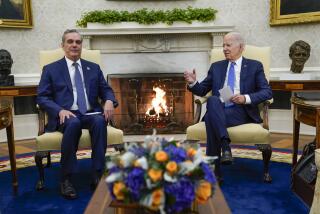Latin America’s next challenges

- Share via
Latin America has had a good decade. Over the last 10 years, economic growth averaged 4.2%, and 70 million people escaped poverty. Macroeconomic stability, open-trade policies and pro-business investment climates have supported and will continue to support strong growth in the years to come.
Crucially, economic gains are being broadly shared. A recent World Bank report found that the middle class in Latin America grew by 50 million people between 2003 and 2009, an increase of 50%. For a region long riven by wealth inequality, this is a remarkable achievement.
As I travel around Latin America this week, I see a region that has come a long way from the “lost decade” of the 1980s and is emerging as a driver of global growth. But we have much more to do to ensure that all of Latin America’s people share in their region’s growing prosperity.
PHOTOS: Brazilians protest rising public transport costs
Although inequality is declining, Latin America remains the world’s most unequal region. From 2008 to 2010, eight of the world’s 10 countries with the highest income inequality were in Latin America, according to the Gini coefficient, the commonly used standard for measuring inequality. Intergenerational mobility also remains limited. A young person’s parents’ economic and social background, as well as whether they were born in a rural or urban area, still largely determines that person’s economic future.
And, in countries that have benefited from the commodity boom of the last decade, the benefits of natural resource wealth have failed to reach all members of society, fueling social tension among those who feel left behind.
If unaddressed, inequity will continue to stoke volatility across the region. But striving for shared growth isn’t just the right thing to do from a social and political perspective; it’s an economic imperative. World Bank research suggests that when poverty levels increase by 10%, growth decreases by 1% and investment falls by as much as 8% of GDP.
VIDEO: Brazil sees biggest protests in more than 20 years
Delivering on the promise of growth will require Latin American policymakers, along with their partners in the development community, including the World Bank, to ensure that economic gains benefit all citizens. Some countries are showing how this can be done.
In Brazil, for example, policy reforms have helped equalize educational attainment. In 1993, the child of a father with no formal education completed, on average, four years of schooling. Today, Brazilian students complete nine to 11 years of schooling, regardless of their parents’ education. This is remarkable progress, although the recent protests in Brazil show that more needs to be done.
Conditional cash transfer programs have also played a role in leveling Latin America’s economic playing field. In the 1990s, Mexico and Brazil pioneered these programs, which provide cash payments to the poor in return for productive activities, such as enrolling children in school and mothers going for medical checkups. Similar programs have sprung up across the region.
We know that overcoming the region’s history of economic inequality is possible. But what will it take to achieve shared prosperity for all?
First, governments must ensure that the market doesn’t leave people behind. Latin America’s strong gains in poverty reduction in the last decade resulted from increased wages and better-targeted social policies. This trend must continue. Leaders must focus in particular on implementing policies that improve business competitiveness and increase productivity, as this is the best way to sustain social and economic progress.
Second, policymakers should do more to provide disadvantaged children with a good education. Doing so would help them acquire the skills needed to get good jobs and enhance social inclusion by empowering poor children to participate more fully in their economies. Attracting talented college graduates to the teaching profession and more effectively holding teachers accountable for their students’ performance can go a long way in improving learning outcomes.
Finally, leaders must improve their ability to deliver services to the poor. Without that, even the best policies will mean little to their intended beneficiaries. The World Bank is providing vital support in this area. For example, we are working with the Peruvian Ministry of Social Development to develop a public expenditure framework that targets government resources to areas where research and experience show they can have the biggest impact in lifting people out of poverty.
Latin America has made tremendous progress in recent years, but more needs to be done. Even as millions rise from poverty and join the region’s burgeoning middle class, people are rightly demanding better services and increased opportunities from their leaders. During my trip, I look forward to learning what it will take to ensure that opportunity and prosperity extend to all of Latin America’s people.
Jim Yong Kim is the president of the World Bank.
More to Read
A cure for the common opinion
Get thought-provoking perspectives with our weekly newsletter.
You may occasionally receive promotional content from the Los Angeles Times.










